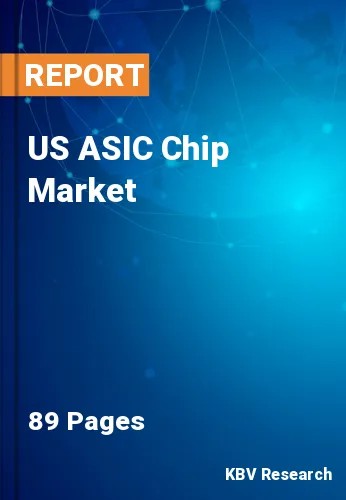Chapter 1. Market Scope & Methodology
1.1 Market Definition
1.2 Objectives
1.3 Market Scope
1.4 Segmentation
1.4.1 US ASIC Chip Market, by Type
1.4.2 US ASIC Chip Market, by End User
1.5 Methodology for the research
Chapter 2. Market Overview
2.1 Introduction
2.1.1 Overview
2.1.1.1 Market Composition and Scenario
2.2 Key Factors Impacting the Market
2.2.1 Market Drivers
2.2.2 Market Restraints
2.2.3 Market Opportunities
2.2.4 Market Challenges
2.2.5 Market Trends
Chapter 3. Competition Analysis - Global
3.1 KBV Cardinal Matrix
3.2 Recent Industry Wide Strategic Developments
3.2.1 Partnerships, Collaborations and Agreements
3.2.2 Product Launches and Product Expansions
3.2.3 Acquisition and Mergers
3.3 Market Share Analysis, 2022
3.4 Top Winning Strategies
3.4.1 Key Leading Strategies: Percentage Distribution (2019-2023)
3.4.2 Key Strategic Move: (Partnerships, Collaborations & Agreements: 2024, Feb – 2019, Feb) Leading Players
3.5 Porter Five Forces Analysis
Chapter 4. US ASIC Chip Market
4.1 US ASIC Chip Market by Type
4.2 US ASIC Chip Market by End User
Chapter 5. Company Profiles – Global Leaders
5.1 Advanced Micro Devices, Inc.
5.1.1 Company Overview
5.1.2 Financial Analysis
5.1.3 Segmental and Regional Analysis
5.1.4 Research & Development Expenses
5.1.5 Recent strategies and developments:
5.1.5.1 Product Launches and Product Expansions:
5.1.5.2 Acquisition and Mergers:
5.1.6 SWOT Analysis
5.2 Samsung Electronics Co., Ltd. (Samsung Group)
5.2.1 Company Overview
5.2.2 Financial Analysis
5.2.3 Segmental and Regional Analysis
5.2.4 Recent strategies and developments:
5.2.4.1 Partnerships, Collaborations, and Agreements:
5.2.5 SWOT Analysis
5.3 ON Semiconductor Corporation
5.3.1 Company Overview
5.3.2 Financial Analysis
5.3.3 Segmental and Regional Analysis
5.3.4 Research & Development Expense
5.3.5 Recent strategies and developments:
5.3.5.1 Partnerships, Collaborations, and Agreements:
5.3.5.2 Acquisition and Mergers:
5.3.6 SWOT Analysis
5.4 Taiwan Semiconductor Manufacturing Company Limited
5.4.1 Company overview
5.4.2 Financial Analysis
5.4.3 Regional Analysis
5.4.4 Research & Development Expenses
5.4.5 SWOT Analysis
5.5 NVIDIA Corporation
5.5.1 Company Overview
5.5.2 Financial Analysis
5.5.3 Segmental and Regional Analysis
5.5.4 Research & Development Expenses
5.5.5 Recent strategies and developments:
5.5.5.1 Acquisition and Mergers:
5.6 Intel Corporation
5.6.1 Company Overview
5.6.2 Financial Analysis
5.6.3 Segmental and Regional Analysis
5.6.4 Research & Development Expenses
5.6.5 Recent strategies and developments:
5.6.5.1 Partnerships, Collaborations, and Agreements:
5.6.5.2 Product Launches and Product Expansions:
5.6.5.3 Acquisition and Mergers:
5.6.6 SWOT Analysis
5.7 Infineon Technologies AG
5.7.1 Company Overview
5.7.2 Financial Analysis
5.7.3 Segmental and Regional Analysis
5.7.4 Research & Development Expense
5.7.5 Recent strategies and developments:
5.7.5.1 Partnerships, Collaborations, and Agreements:
5.7.5.2 Product Launches and Product Expansions:
5.7.5.3 Acquisition and Mergers:
5.7.6 SWOT Analysis
5.8 Texas Instruments, Inc.
5.8.1 Company Overview
5.8.2 Financial Analysis
5.8.3 Segmental and Regional Analysis
5.8.4 Research & Development Expense
5.8.5 SWOT Analysis
5.9 Seiko Epson Corporation
5.9.1 Company Overview
5.9.2 Financial Analysis
5.9.3 Segmental and Regional Analysis
5.9.4 Research & Development Expenses
5.9.5 SWOT Analysis
5.10. BITMAIN Technologies Holding Company
5.10.1 Company Overview
5.10.2 Recent strategies and developments:
5.10.2.1 Partnerships, Collaborations, and Agreements:
5.10.2.2 Product Launches and Product Expansions:
5.10.3 SWOT Analysis

